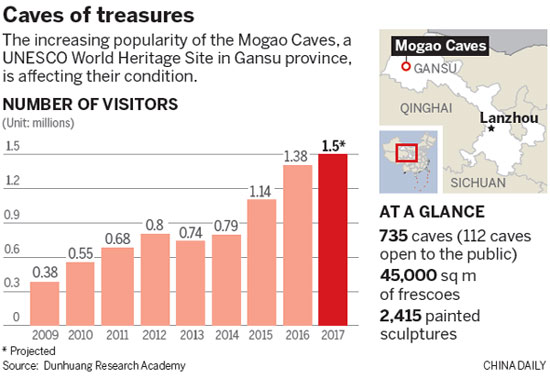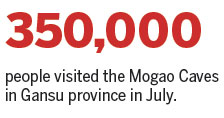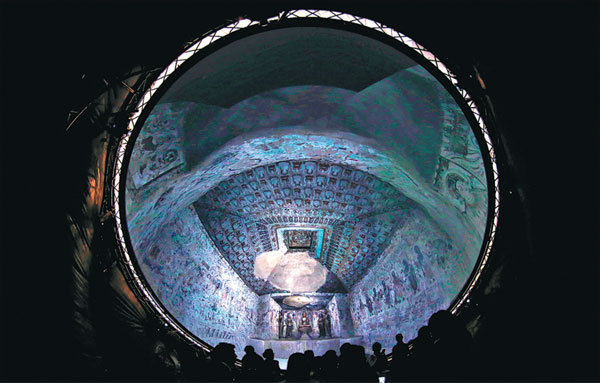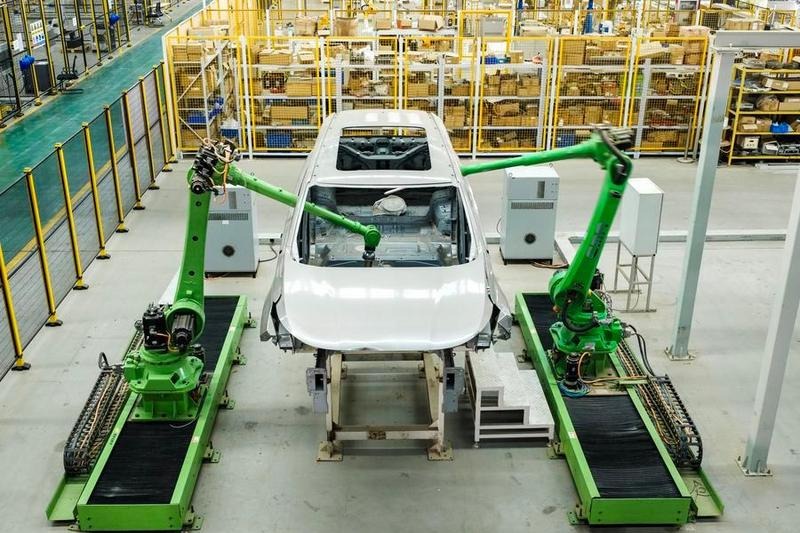Tourism popularity endangers caves

Digitization, internet traffic used to ease number of visitors
The popularity of the Mogao Caves, which house the world's largest collection of Buddhist art, is proving their biggest threat.
The caves, in Northwest China's Gansu province, already have received many more visitors this summer than they can handle, and this is altering their environment. But new technology may help save them from their own success.
In July, 350,000 people visited the caves, twice the monthly limit and 20 percent more than in July 2016, according to officials at the Dunhuang Research Academy, which manages the caves, where the art has survived for centuries.
| A visitor views a duplicate of Dunhuang frescoes in Lanzhou, Gansu province, early this year. Fan Peishen / Xinhua |
| The art of Mogao Caves was displayed with 3-D technology during the Summer Davos Forum in Dalian, Liaoning province, in 2015. Yao Jianfeng / Xinhua |

The single-day peak number of visitors in July exceeded 18,000, triple its daily maximum, says Li Ping, who is in charge of visitor reception.
"The humidity and temperature inside the caves increases with too many tourists," says Li, adding that the moisture and carbon dioxide they exhale cause irreparable damage to frescoes and painted sculptures. Sand and wind also pose a threat. Archaeologists say the caves are deteriorating more rapidly than in the past.
To reduce the damage, a maximum of 6,000 visitors in the caves are allowed per day. Tourists can book a month in advance on the internet. But this summer, reservations have filled up quickly.
The caves, 25 kilometers southeast of downtown Dunhuang, have seen an increasing number of visitors since they were opened to the public in the late 1970s, especially after they became a UNESCO World Heritage Site in 1987.
Finding a balance between preserving the 1,651-year-old site and the demands of tourism has become more urgent, and the academy has adopted a series of measures to try to strike a balance, aside from limiting daily visits.
Zhang Xiantang, deputy director of the academy, says digitization of murals inside the Dnhuang caves is the most effective way to protect them. Before visitors start their tour of the real caves, they are led first to the visitor center, where 3-D movies using digital technology are shown to display the frescoes and sculptures in some caves closed to the public for preservation.
This has helped visitors get better background knowledge and reduce their stay in the actual caves. The academy allows each visitor to examine eight caves a day and limits the combined time inside to 75 minutes.
Each cave has hundreds of figures on its walls, mostly of the Buddha, including palm-size artwork. Visitors cannot get a good look at details of the murals, staying in the dimly lit caves for just a few minutes.
But with high-definition prints displayed in museums, people can see the details clearly, Zhang says. The project has enabled the "unmovable museum on walls" to be shown anywhere in the world with 3-D technology.
There are 2,415 painted sculptures and 45,000 square meters of frescoes inside the 735 caves, the earliest dating back to 366 AD.
So far, the academy has finished collecting data on 119 caves, of which 30 can be viewed online at e-dunhuang.com, according to Yu Tianxiu, who has worked for years on their digitization. The website, which launched on May 1, 2016, will have an updated version by the end of this year, offering more pictures and interactive experiences.
"It takes a month to photograph a painting and process the information online," Yu says.

The Dunhuang digitization began in the 1990s after it became apparent that the frescoes needed protection from heat, humidity and carbon dioxide.
"The odor of perfume can linger in a cave for days and harm the frescoes," says Bian Lei, a tourist guide at the caves. "The colors are fading, too. I can see that."
It will be difficult to complete the digitization of all the caves. A photo of a painting on a wall now needs 60 gigabytes of storage space, similar to that of a smartphone, because one photo often has several thousands parts.
In July, Seagate Technology, a US data-storage company, provided the academy with assistance and donated $78,000 to support the digitization of cave 307, which has many images of children.
"Lots of high-tech companies want to cooperate with us. But many soon leave because they underestimate the time and patience that is needed for the preservation," Yu says. "It's a lifetime career."
Apart from taking photos and processing them over months, Yu and his team also use the data to replicate the look of sculptures and murals through 3-D printing technology. Visitors can see the replicas of eight caves in front of the real caves. They also are part of the academy's digitization project and have been exhibited in many cities in China, as well as in the United States, Japan, Australia and Russia.
dengzhangyu@chinadaily.com.cn
(China Daily Africa Weekly 08/18/2017 page21)
Today's Top News
- Foreign ministers of China, Egypt call for Gaza progress
- Shield machine achieves Yangtze tunnel milestone
- Expanding domestic demand a strategic move to sustain high-quality development
- Xi hears report from Macao SAR chief executive
- Xi hears report from HKSAR chief executive
- UN envoy calls on Japan to retract Taiwan comments
































